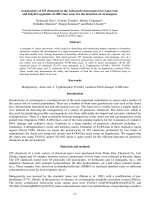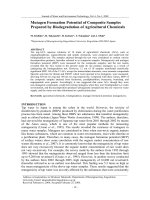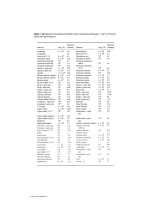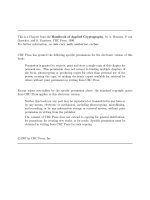Handbook of inorganic chemicals
Bạn đang xem bản rút gọn của tài liệu. Xem và tải ngay bản đầy đủ của tài liệu tại đây (4.63 MB, 1,125 trang )
Patnaik_FM_049439-8
11/11/02
3:11 PM
Page i
Handbook of Inorganic
Chemicals
Pradyot Patnaik, Ph.D.
McGraw-Hill
New York Chicago San Francisco Lisbon London
Madrid Mexico City Milan New Delhi San Juan Seoul
Singapore Sydney Toronto
Patnaik_FM_049439-8
11/11/02
3:11 PM
Page ii
www.pdfgrip.com
Library of Congress Cataloging-in-Publication Data
Patnaik, Pradyot.
Handbook of inorganic chemicals / Pradyot, Patnaik.
p.
cm.
Includes bibliographical references and index.
ISBN 0-07-049439-8
1. Inorganic compounds—Handbooks, manuals, etc. I. Title.
QD155.5P37
2002
546—dc21
2002029526
Copyright © 2003 by The McGraw-Hill Companies, Inc. All rights reserved.
Printed in the United States of America. Except as permitted under the United
States Copyright Act of 1976, no part of this publication may be reproduced or
distributed in any form or by any means, or stored in a data base or retrieval
system, without the prior written permission of the publisher.
1 2 3 4 5 6 7 8 9 DOC/DOC
0 9 8 7 6 5 4 3 2
ISBN 0-07-049439-8
The sponsoring editor for this book was Kenneth McComb, the editing supervisor was Daina Penikas, and the production supervisor was Sherri Souffrance.
Printed and bound by RR Donnelley.
McGraw-Hill books are available at special quantity discounts to use as premiums and sales promotions, or for use in corporate training programs. For
more information, please write to the Director of Special Sales, Professional
Publishing, McGraw-Hill, Two Penn Plaza, New York, NY 10121-2298. Or contact your local bookstore.
This book is printed on recycled, acid-free paper containing
a minimum of 50% recycled, de-inked fiber.
Information contained in this work has been obtained by The McGraw-Hill
Companies, Inc. (“McGraw-Hill”) from sources believed to be reliable. However,
neither McGraw-Hill nor its authors guarantee the accuracy or completeness of
any information published herein and neither McGraw-Hill nor its authors shall
be responsible for any errors, omissions, or damages arising out of use of this
information. This work is published with the understanding that McGraw-Hill
and its authors are supplying information but are not attempting to render engineering or other professional services. If such services are required, the assistance of an appropriate professional should be sought.
Patnaik_FM_049439-8
11/11/02
3:11 PM
Page v
www.pdfgrip.com
Preface
This handbook is an encyclopedic treatment of chemical elements and their
most important compounds intended for professionals and students in many
areas of chemistry throughout the manufacturing, academic, and consulting
communities. Chemicals are presented in alphabetical order in a descriptive
format highlighting pertinent information on physical, chemical, and thermodynamic properties of chemicals, methods of preparation, industrial applications, chemical analyses, and toxic and hazardous properties. Synonyms, CAS
Registry Numbers, brief history of discovery and natural occurrence are provided for many entries. The objective is to provide readers a single source for
instant information about important aspects each substance. In this sense it
should serve as a combination handbook and encyclopedia.
Readers may note three unique features in this text. First, there is a substantial discussion of chemical reactions of all elements and many of their compounds, a practice abandoned nowadays by most modern reference and
handbooks. Second, analytical methods are presented for identification and
measurement of practically all entries. In many instances, the method is based
on my own research and experience. Third, a preparation method is given for
all entries. For most compounds, more than one preparative method is presented, covering both laboratory and commercial production. Also, a brief history of the discovery and early production of selected elements is presented to
serve as background against which modern methods may be judged and historical perspective maintained.
It has been a hard task indeed to select a limited number of compounds from
among over one hundred thousand inorganic chemicals used in industry.
Because of space limitations, only a small number have been selected as main
entries, but many more have been cited under each entry.
I hope that you find this book useful, and that you will let the publisher and
me know how we may make it more useful to you.
Pradyot Patnaik,
Burlington, NJ.
November, 2001
v
Patnaik_FM_049439-8
11/11/02
3:11 PM
Page vi
www.pdfgrip.com
Acknowledgments
I wish to thank Dr. Jan C. Prager for manuscript editing and for all his valuable comments. Mrs. Mary Ann Richardson typed the manuscript in a careful
and timely manner, and I am most grateful for her efforts. Also, I thank Mr.
Ken McCombs, Acquisition Editor, for his help, advice, and patience; Mr. Bob
Esposito, his predecessor, for initiating the project; Daina Penikas and many
other production staff at McGraw-Hill who have helped along the way. Last,
and most important, I thank my wife Sanjukta for her many sacrifices of family time, her unwavering encouragement, and confident support.
vi
Patnaik_FM_049439-8
11/11/02
3:11 PM
Page vii
www.pdfgrip.com
Introduction
All of the elements and many important compounds are presented in this reference. Substances are arranged in alphabetical order. Each entry topic is discussed briefly below.
Elements
Chemical names are followed by Chemical Abstract Service (CAS) registry
numbers. This is followed by symbols, atomic numbers, atomic weights, group
numbers in the Periodic Table (the older but more common CAS system and
the present IUPAC Group numbers given in parentheses), electron configuration, valence states, most stable oxidation states, and atomic and ionic radii.
Naturally occurring stable isotopes, abundance, artificial radioactive isotopes
and longest- and shortest-lived radioisotopes with half-lives are presented for
all elements. Additionally for many elements, electronegativity and standard
electrode potential data are presented.
The next section under “Elements” is subtitled “History, Occurrence and
Uses.” This includes a brief history of chemical discoveries and the origin of
their names and symbols, natural occurrence, principal minerals, abundance
in the earth’s crust and in sea water and principal uses. Uses include commercial applications, preparative reactions, analytical applications and other laboratory reactions. More general information is provided in this section.
The “Physical Properties” are listed next. Under this loose term a wide range
of properties, including mechanical, electrical and magnetic properties of elements are presented. Such properties include color, odor, taste, refractive index,
crystal structure, allotropic forms (if any), hardness, density, melting point, boiling point, vapor pressure, critical constants (temperature, pressure and volume/density), electrical resistivity, viscosity, surface tension, Young’s modulus,
shear modulus, Poisson’s ratio, magnetic susceptibility and the thermal neutron
cross section data for many elements. Also, solubilities in water, acids, alkalies,
and salt solutions (in certain cases) are presented in this section.
Under the title “Thermochemical Properties,” both thermodynamic and thermal properties appear. These include thermodynamic properties, enthalpies of
formation, Gibbs free energy of formation, entropies and heat capacities, and
vii
Patnaik_FM_049439-8
11/11/02
3:11 PM
Page viii
www.pdfgrip.com
viii
Introduction
thermal properties such as thermal conductivities, coefficient of linear expansion, heat of fusion, and the heat of vaporization.
Under the “Recovery” or “Production” mining of ores, ore opening, separation, and isolation into pure elements are touched upon briefly.
The “Reactions” section highlights only important reactions that include formation of binary compounds, oxo salts, and complexes.
The “Analysis” section includes qualitative identification and quantitative
measurement of the element in free elemental form or its compounds and alloys.
“Toxicity” or “Hazard” sections are presented last to illustrate dangerous
properties of elements and compounds that are toxic, flammable, explosive, or
otherwise harmful.
Compounds
Compounds of the elements are also presented in similar format. This includes
CAS Registry Numbers, formulas, molecular weights and the hydrates they form
(if any). This is followed by occurrence (for naturally occurring compounds) and
industrial applications. The section on “Physical Properties” covers the color, crystal structure, density, melting and boiling points and solubilities of the compounds in water, acids, alkalies and organic solvents.
“Thermochemical Properties” mostly covers heats of formation, Gibbs free
energy, entropies, and heat capacities. For many compounds, heats of fusion
and vaporization are included.
Under the heading “Preparation” or “Production,” preparative processes are
described briefly. Chemical equations are shown wherever applicable. While
“Preparation” refers to laboratory method or a general preparative method, the
term “Production” refers to commercial manufacturing processes. For many
compounds both historical preparative methods and those in common use are
described.
The section “Analysis” starts with elemental composition of the compound.
Thus the composition of any compound can be determined from its elemental
analysis, particularly the metal content. For practically all metal salts, atomic
absorption and emission spectrophotometric methods are favored in this text
for measuring metal content. Also, some other instrumental techniques such as
x-ray fluorescence, x-ray diffraction, and neutron activation analyses are suggested. Many refractory substances and also a number of salts can be characterized nondestructively by x-ray methods. Anions can be measured in aqueous
solutions by ion chromatography, ion-selective electrodes, titration, and colorimetric reactions. Water of crystallization can be measured by simple gravimetry or thermogravimetric analysis.
A section on “Toxicity” is presented in many entries for poisonous and carcinogenic substances. If a substance is flammable or explosive or toxic, the section is subtitled “Hazard.” Only substances that manifest poisoning effects
even at small doses or are highly corrosive, or highly flammable or reactive are
mentioned in this section, although most substances can be hazardous at high
doses or under unusual conditions.
Patnaik_FM_049439-8
11/11/02
3:11 PM
Page ix
www.pdfgrip.com
Definitions
General and Physical Properties
Electron configuration of an atom indicates its extranuclear structure; that
is, arrangement of electrons in shells and subshells. Chemical properties of
elements (their valence states and reactivity) can be predicted from electron
configuration.
Valence state of an atom indicates its power to combine to form compounds.
It also determines chemical properties.
Electronegativity refers to tendency of an atom to pull electrons towards
itself in a chemical bond. Nonmetals have high electronegativity, fluorine being
the most electronegative while alkali metals possess least electronegativity.
Electronegativity difference indicates polarity in the molecule.
Ionization potential is the energy required to remove a given electron from
its atomic orbital. Its values are given in electron volts (eV).
Isotopes are atoms of the same elements having different mass numbers.
Radioisotopes are the isotopes of an element that are radioactive or emit ionizing radiation. All elements are known to form artificial radioactive isotopes by
nuclear bombardment.
Half-life of a radioactive isotope is the average time required for one-half the
atoms in a sample of radioactive element to decay. It is expressed as t1/2 and is
equal to:
t1/2 ϭ ln 2/λ , where λ is a decay constant.
Atomic radius refers to relative size of an atom. Among the main group of elements, atomic radii mostly decrease from left to right across rows in the
Periodic Table. Going down in each group, atoms get bigger. Ionic radius is a
measure of ion size in a crystal lattice for a given coordination number (CN).
Metal ions are smaller than their neutral atoms, and nonmetallic anions are
larger than the atoms from which they are formed. Ionic radii depend on the
element, its charge, and its coordination number in the crystal lattice. Atomic
and ionic radii are expressed in angstrom units of length (Å).
Standard electrode potential is an important concept in electrochemistry.
Standard potentials for many half-reactions have been measured or calculated.
It is designated as Eϒ and expressed in volts (V). From the values of E° one can
ix
Patnaik_FM_049439-8
11/11/02
3:11 PM
Page x
www.pdfgrip.com
x
Definitions
predict if a species will be oxidized or reduced in solution (under acidic or basic
conditions) and whether any oxidation-reduction reaction will take place.
Solubility data are presented for practically all entries. Quantitative data
are also given for some compounds at different temperatures. In general, ionic
substances are soluble in water and other polar solvents while the non-polar,
covalent compounds are more soluble in the non-polar solvents. In sparingly
soluble, slightly soluble or practically insoluble salts, degree of solubility in
water and occurrence of any precipitation process may be determined from the
solubility product, Ksp, of the salt. The smaller the Ksp value, the less its solubility in water.
Hardness measures ability of substances to abrade or indent one another.
Several arbitrary scales have been developed to compare hardness of substances.
Mohs hardness is based on a scale from 1 to 10 units in which diamond, the hardest substance, is given a value of 10 Mohs and talc given a value of 0.5.
Vapor pressure is exerted by a solid or liquid in equilibrium with its own
vapor. All liquids have vapor pressures. Vapor pressure depends on temperature and is characteristic of each substance. The higher the vapor pressure at
ambient temperature, the more volatile the substance. Vapor pressure of water
at 20ºC is 17.535 torr.
Refractive index or index of refraction is the ratio of wavelength or phase
velocity of an electromagnetic wave in a vacuum to that in the substance. It
measures the amount of refraction a ray of light undergoes as it passes through
a refraction interface. Refractive index is a useful physical property to identify
a pure compound.
Temperature at the critical point (end of the vapor pressure curve in phase
diagram) is termed critical temperature. At temperatures above critical temperature, a substance cannot be liquefied, no matter how great the pressure.
Pressure at the critical point is called critical pressure. It is the minimum pressure required to condense gas to liquid at the critical temperature. A substance
is still a fluid above the critical point, neither a gas nor a liquid, and is referred
to as a supercritical fluid. The critical temperature and pressure are expressed
in this text in ºC and atm, respectively.
Viscosity is a property of a fluid indicating its resistance to change of form (or
resistance to flow). It is expressed as g/cm sec or Poise; 1 Poise ϭ 100 centipoise.
Surface tension occurs when two fluids are in contact with each other. This
is caused by molecular attractions between the molecules of two liquids at the
2
surface of separation. It is expressed as dynes/cm or ergs/cm .
Modulus of elasticity is the stress required to produce unit strain to cause a
change of length (Young’s modulus), or a twist or shear (shear modulus), or a
change of volume (bulk modulus). It is expressed as dynes/cm2.
Thermochemical and Thermal Properties
The enthalpy of formation, ∆Hf°, is the energy change or the heat of reaction in
which a compound is formed from its elements. Two examples are shown below:
Ca(s) + O2(g) + H2(g) → Ca(OH)2(s)
∆Hrxn ϭ –235.68 kcal
Patnaik_FM_049439-8
11/11/02
3:11 PM
Page xi
www.pdfgrip.com
Definitions
N2(g) + 3H2(g) → 2NH3(g)
xi
∆Hrxn ϭ –22.04 kcal
The ∆Hf° in the above reactions are –235.68 and –11.02 kcal/mol, respectively. In the second case, the value of ∆Hf° is one-half of ∆Hrxn since two moles
of NH3 are produced in the reaction. Also note that ∆Hf° refers to the formation
of a compound from its elements only at the standard state (25°C and 1 atm),
and not the formation from other compound(s).
The term ∆Gf° refers to the standard free energies of formation of compounds
at 25°C and 1 atm. Its relation with enthalpy change, ∆H, and entropy change,
∆S, at a temperature T (in °K) can be expressed as:
∆G ϭ ∆H – T∆S
The value of ∆Gf° can be calculated from the above equation and from
other equations also.
Entropy is a thermodynamic quantity that is a measure of disorder or randomness in a system. When a crystalline structure breaks down and a less
ordered liquid structure results, entropy increases. For example, the entropy
(disorder) increases when ice melts to water. The total entropy of a system and
its surroundings always increases for a spontaneous process. The standard
entropies, S° are entropy values for the standard states of substances.
Heat capacity, Cρ is defined as the quantity of thermal energy needed to raise
the temperature of an object by 1°C. Thus, the heat capacity is the product of
mass of the object and its specific heat:
Cρ ϭ mass ϫ specific heat
Specific heat is the amount of heat required to raise the temperature of one
gram of a substance by 1°C. The specific heat of water is 1 calorie or 4.184 Joule.
The heat of fusion, ∆Hfus is the amount of thermal energy required to melt
one mole of the substance at the melting point. It is also termed as latent heat
of fusion and expressed in kcal/mol or kJ/mol.
The heat of vaporization, ∆Hvap, is the amount of thermal energy needed to
convert one mole of a substance to vapor at boiling point. It is also known as
latent heat of vaporization and expressed kcal/mol or kJ/mol.
Thermal conductivity measures the rate of transfer of heat by conduction through unit thickness, across unit area for unit difference of temperature.
It is measured as calories per second per square centimeter for a thickness of
one centimeter and a temperature difference of 1°C. Its units are cal/cm sec.°K
or W/cm°K.
The coefficient of linear thermal expansion is the ratio of the change in
length per degree C to the length at 0°C.
Analysis
All metals at trace concentration, or in trace quantities, can be analyzed by
atomic absorption (AA) spectrophotometry in flame or graphite furnace (electrothermal reduction) mode. A rapid, multi-element analysis may use
Patnaik_FM_049439-8
11/11/02
3:11 PM
Page xii
www.pdfgrip.com
xii
Definitions
advanced instruments available commercially. Also, Inductively Coupled
Plasma Atomic Emission Spectrophotometric methods (ICP-AES) are rapid,
versatile, and multi-element analytical methods. They offer certain advantages over flame or furnace AA. ICP/MS (mass spectrometry) is the most sensitive technique because it provides a detection level over one hundred times
lower than AA or ICP. For all such analyses, solid compounds must be dissolved in water by acid digestion or alkali fusion. Other instrumental techniques for metal analyses include x-ray fluorescence, x-ray diffraction,
neutron activation analysis, and ion-specific electrode methods. Also, colorimetric methods that are prone to interference effects may be applied to identify metals in their pure salts.
Anions may be measured best by ion chromatography, using appropriate
anion exchange resin columns that are available commercially. Salts may be
diluted for such measurements. Ion-selective electrode methods also yield satisfactory results at trace concentrations. Numerous colorimetric methods are
reported in literature. They are susceptible to erroneous results when impurities are present. Many titration methods are available in analytical chemistry.
They may be applied successfully to measure certain anions, oxidizing and
reducing substances, acids, and bases.
Thermogravimetric analysis (TGA) and the differential thermal analysis
(DTA) may be used to measure the water of crystallization of a salt and the
thermal decomposition of hydrates.
Substances also can be identified from physical properties such as density,
melting and boiling points, and refractive index. Elemental analysis can confirm the identity of a compound.
Hazard
Toxicity of many entries are expressed quantitatively as LD50 (median lethal
dose) or LC50 (median lethal concentration in air). The latter refers to inhalation toxicity of gaseous substances in air. Both these terms refer to the calculated concentration of a chemical that can kill 50% of test animals when
administered.
A substance is usually termed “flammable” if its flash point is below 100°F
(38°C).
Patnaik_FM_049439-8
11/11/02
3:11 PM
Page xiii
www.pdfgrip.com
Some Physical Constants
Velocity of light, c ϭ 2.9979 ϫ 108 m/s (in vacuum)
Planck’s constant, h ϭ 1.05457 ϫ 10–34 J.s
Rydberg constant, RH ϭ 2.17991 ϫ 10–18 J
Boltzmann constant, k ϭ 1.3807 ϫ 10–16 erg/K
Acceleration of gravity, g ϭ 980.6 cm/s
Electron mass, me ϭ 9.1094 ϫ 10–31 kg
Proton mass, mr ϭ 1.6726 ϫ 10–27 kg
Neutron mass, mn ϭ 1.6749 ϫ 10–27kg
Proton-electron mass ratio ϭ 1836
Atomic mass unit (amu) ϭ 1.6605 ϫ 10–27 kg
Electron charge, e ϭ 1.60219 ϫ 10–19 C
Faraday constant, F ϭ 9.648456 ϫ 104 C
Avogadro constant ϭ 6.022 ϫ 1023/mol
Molar volume at STP ϭ 22.41384 L
Molar gas constant, R ϭ 0.08026 L. atm/mol. K
ϭ 8.3145 J/mol. K
ϭ 1.9872 cal/mol. K
xiii
Patnaik_FM_049439-8
11/11/02
3:11 PM
Page xiv
www.pdfgrip.com
Units and Conversion
Temperature
°C ϭ (°F –32)/1.8
°F ϭ 1.8°C + 32
°K ϭ °C + 273.15
Pressure
1 atm ϭ 101.365 KPa
ϭ 101,365 Pa
ϭ 0.101365 MPa
1 MPa ϭ 9.87 atm
1 atm ϭ 760 torr ϭ 760 mm Hg
1 atm ϭ 14.696 psi
1 KPa ϭ 7.50 torr
Volume
1 L ϭ 1,000 mL
1 mL ϭ 1 cubic centimeter (cc)
1 m3 ϭ 1000 L
1 gal (US) ϭ 3.784 L
1 quart (qt) ϭ 946.4 mL
1 tablespoon ϭ 14.79 mL
1 teaspoon ϭ 4.93 mL
Energy
1 cal ϭ 4.184 J
1 kcal ϭ 1,000 cal
1 kJ ϭ 1,000 J
1 eV ϭ 1.602 ϫ 10–19 J
1 MeV ϭ 1.602 ϫ 10–13 J
xiv
Patnaik_FM_049439-8
11/11/02
3:11 PM
Page xv
www.pdfgrip.com
Units and Conversion
Distance, Bond Length and Atomic Radii
1 km ϭ 1,000 m
1 m ϭ 100 cm or 1,000 mm
1 mm ϭ 1,000 µm
1 µm ϭ 1,000 mm
1 nm ϭ 1,000 pm
1 m ϭ 106 mm or 109 nm
1 mho ϭ 1 siemen (S)
1 Å ϭ 10–10 m
1 Å ϭ 10pm
1 micron ϭ 1 micorometer (µm)
Density
Solid ϭ g/cm3
Liquid ϭ g/mL
Gas ϭ g/L
Density of gas/vapor at STP ϭ molecular wt(g)/22.4 L
Vapor density (times heavier than air) ϭ molecular wt/29
Concentration
1ppm (w/w) ϭ 1mg/L (in aqueous solution)
1M ϭ mol/L
1N ϭ gram equivalent weight/L
1 m ϭ mol/kg solvent
Miscellaneous
1dyne/cm2 ϭ 0.10 Pa
1 erg ϭ 10–7 J
1 erg/s ϭ 10–7watt (W)
1 Faraday ϭ 96,495 coulomb (C)
1 inch ϭ 2.54 cm
1 mho ϭ 1 siemen (S)
1 ohm.cm ϭ 10–2 ohm.cm
6
1 ohm.cm ϭ 10 microhm.cm
1 centipoise ϭ 0.001 Pascal-second
1 centistoke ϭ 1 ϫ 10–6 m2/sec
xv
www.pdfgrip.com
Bibliography
Some general bibliographic references follow. Additional references from journals and historical literature have been cited in the text.
1. Kirk-Othmer Encyclopedia of Chemical Zkchnology, 31ded., Vol 1-23, 1970-86; New York John
Wiley & Sons
2. The Encyclopedia of Chemical Elements, ed. Clifford A. Hempel, 1968, New York: Reinhold
Book Corporation
3. CRC Handbook of Chemistry and Physics, 77" ed., edited. David R. Lide, 1999, Boca Raton:
CRC Press
4. Cotton, F.A., Wilkinson, G., Murillo, C.A. and M. Bochmann. 1999. Advanced Inorganic
Chemistry, 6thed., New York: John Wiley & Sons
5. Patnaik, P. 1999. A Comprehensive Guide to the Hazardous Properties of Chemical
Substances, Znd ed. New York John Wiley & Sons
6. Lewis(Sr.), R.J. 1996 Sax's Dangerous
Properties of Industrial Materials, gthed. New York:
Van Nostrand Reinhold
7. The Merck Index, 12thed,edited. Susan Budavery, 1995 Rahway, NJ: The Merk and
Company, Inc.
8. American Public Health Association, American Water Works Association and Water
Environment Federation. 1999. Standard Methods for the Examination of Water and
Wastewater, 20thed. Edited Arnold E. Greenberg, Lenore S. Clesceri, and Andrew D. Easton.
Washington, DC: American Public Health Association.
9. The Merck Index, 12thed, edited. Susan Budavery, 1995 Rahway, NJ: The Merck and
Company, Inc.
10. American Public Health Association, American Water Works Association and Water
Environment Federation. 1999. Standard Methods for the Examination of Water and
Wastewater, 20thed. Edited Arnold E. Greenberg, Lenore S. Clesceri and Andrew D. Easton.
Washington, DC: American Public Health Association
11. Patnaik, P. 1997. Handbook of Environmental Analysis, Boca Raton: CRC Press
12. Skoog, D.A. West, D.M. and F. James Holler. 1992. Fundamentals ofAnaZytica1 Chemistry,
6thed. 1992. New York: Saunders College Publishing
13. Silberberg, M. 1996. Chemistry, The Molecular Nature of Matter and Change, St. Louis:
Mosby
14. H. Remy. 1956. Deatise on Theoretical and Inorganic Chemistry, Amsterdam: Elsevier
Publishing Company
www.pdfgrip.com
ABBREVIATIONS AND STANDARD LElTER SYMBOLS
Absorbance (decaidic)
Absorption coefficient, linear decaidic
Activation energy
Activity (radioactive)
Adjusted retention time
Adjusted retention volume
Alcohol
Alkaline
Alpha particle
Alternating current
Amorphous
Amount concentration
Amount of substance
Ampere
Angle of optical rotation
Angstrom
Angular dispersion
Angular velocity
Anhydrous
Approximate
Aqueous solution phase
Area
Atmosphere, unit of pressure
Atomic mass unit
Atomic percent
Atomic weight
Average
Average line7 gas velocity
Band width ‘
Bar, unit of pressure
Barn, cross section (radioactivity)
Base of natural logarithms
Becquerel
Bed volume
Beta particle
Bohr magneton
Boiling point
Boltzmann constant
Bragg angle
Butyl
Calorie, unit of energy
Capacitance
Celsius temperature
Charge number of an ion
A
a
E.
A
tfc
v;
alC
alk
a
ac
am
c
n
A
a
A
dWdA
w
anhyd
ca.
aq
A
atm
amU
at.%
at. wt.
ay --P
UZ
bar
b
e
Bq
V8
B
PB
bP
4
e
Bu
Cal
c
t
I
Chemical shift
Citrate
Compare (confer)
Concentration at peak maximum
Concentrationof solute in mobile phase
Concentration of solute in stationary
phase
Conductance
Conductivity
Coulomb
critical temperature
Cross section
Curie
Cycles per second
Dalton (atomic mass unit)
Decay constant (radioactive)
Decompose
Degree of dissociatioa
Degrees Celsius
Density, critical
Detect, determine(d)
Diffusion coefficient
Diffusion coefficient, mobile phase
Diffusion coefficient, stationary phase
Diffusion current
Dilute
Direct current
Disintegration per minute
Distribution ratio
Dropping mercury electrode
Electric current
Electric potential
Elegrical resistance
Electromotive force
Electron
Electronvolt
Equivalent weight
I
~
et alii (and others)
et cetera (and so forth)
Ethyl
Ethylenediamine-N,N,N’~’-te~acetic acid
s
Cit
cf.
~ n u x
chi
cs
G
K
c
tc
u
Ci
Hz
Da
A
dec
a
“C
dc
det(d)
D
DM
DS
id
dil
dc
dPm
D
dme
I
V
R
E, emf
e-, e
eV
equiv wt,
eq wt
et al.
etc.
Et
EDTA
www.pdfgrip.com
ABBREVIATIONS AND STANDARD LETTER SYMBOLS (Contlnud)
ExempIi gratia
Exponenfial
Faraday constant
Flowrate, column chromatography
Frcczing point
Gamma radiation
Gas (physical state)
Gas constant
Gauss
oram
Half-life
Half-wave potential
Hcrtz
Hour
Hygroscopic
ibidem (in the same place)
id est (that is)
Inch
Inorganic
Inside diameter
Insoluble
In the same place
In the work cited
Joule
Kelvin
KilOLiter
Logarithm, common
Logarithm, base e
Mass absorption coefficient
Maximum
Melting point
Meter
Milliequivalent
Millimeten of mercury, pressure unit
Millimole
Minute
Molar
Mole
Mole percent
Molecular weight
Neutron
Nuclear magnetic resonance
e.g.
eXP
F
Fc
fP
Y
g
R
G
g
tl,
El,
Hz
h
hYgr
ibid.
i.e.
in'
inorg
i.d.
insol
ibid.
op. cit.
J
K
kL
log
In
dP9IS.
m$x
mP
m
meq
mM
rn,min
M
mol
mol 46
mol wt
n
NMR
Ohm
n
Organic
Outer diameter
Oxalate
org
0.d.
ox
oxidant
Pagds)
Partition ratio
Parts per billion, volume
Parts per billion, weight
Parts per million, volume
Parts per million, weight
Pascal
Peak resolution
pH, expressed in activity
expressed in molarity
Phenyl
Plate number, effective
Pounds per square inch
Pressure, critical
hPYl
Pyridine
Radiofrtquency
Reductant
Retardation factor
Retention time
Retention volume
Saturated
Saturated calomel electrode
Second
Signal-to-noise ratio
Slightly
'Solid _.
Soluble
Solution
I
Solvent
Standard
Tartrate
Transit time of nonretained solute
Ultraviolet
vacuum
Velocity
t
Versus
Volt
Volume
Volume mobile phase in volume
Volume per volume
Weight
Weight percent
Weight per volume
Zone width at base
Zone wid& at one-half peak height
~
ox
P. @PJ
k'
ng/mL
ns/e
Pfm-
Pg43
Pa
Rs
PH
PH
Ph
Neff
psi
Pc
Pr
PY
rf
red
Rf
a
tR
VR
satd
SCE
S
S/N
sl
c, s
sol
soln
solv
Std
tart
r'u, to
uv
vac
u, w
vs
V
KV
v
b
4
vlv
W
wt%
WIV
W,
w;,
www.pdfgrip.com
About the Author
Pradyat Patnaik, Ph.D., is Director of the Laboratory of the Interstate
Environmental Commission at Staten Island, NY. He also teaches as a n
Adjunct Professor at the New Jersey Institute of Technology in Newark, NJ,
,and Community College of Philadelphia and does his research in the Center
for Environmental Science at the City University of New York on Staten
Island. His diverse interests include chemical processing, product development, catalysis, reaction mechanisms, environmental pollutants, and mass
spectrometry.
Dr. Patnaik was a post-doctoral research scientist at Cornell University,
Ithaca, NY.His B.S. and M.S.in chemistry are from Utkal University, India,
and his Ph.D. from the Indian Institute of Technology, Bombay.
Dr. Patnaik has written two other books, A Comprehensive Guide to the
Hazardous Properties of Chemical Substances, and Handbook of Environmental
Analysis.
www.pdfgrip.com
Table of Contents
Front Matter
Preface
Acknowledgments
Introduction
Definitions
Some Physical Constants
Units and Conversion
Table of Contents
Actinium … Ammonium Phosphate, Dibasic
Actinium
Aluminum
Aluminum Bromide
Aluminum Chloride
Aluminum Chloride Hexahydrate
Aluminum Hydride
Aluminum Nitrate
Aluminum Nitride
Aluminum Oxide
Aluminum Phosphate
Aluminum Sulfate
Aluminum Sulfate Octadecahydrate
Americium
Ammonia
Ammonium Acetate
Ammonium Bicarbonate
Ammonium Bifluoride
Ammonium Bromide
Ammonium Carbamate
Ammonium Carbonate
Ammonium Chloride
Ammonium Cyanide
Ammonium Dichromate
Ammonium Fluoride
xiii
i
iii
iv
v
vii
xi
xii
xiii
1
1
2
4
6
7
8
9
10
11
13
14
15
15
19
24
25
26
28
29
30
30
33
34
35
www.pdfgrip.com
Ammonium Formate
Ammonium Hydrosulfide
Ammonium Molybdate
Ammonium Nitrate
Ammonium Phosphate, Dibasic
Ammonium Phosphate, Monobasic … Barium Hydroxide
Ammonium Phosphate, Monobasic
Ammonium Sulfate
Ammonium Sulfide
Ammonium Thiocyanate
Ammonium Thiosulfate
Antimony
Antimony Pentachloride
Antimony Pentafluoride
Antimony Pentasulfide
Antimony Pentoxide
Antimony Trichloride
Antimony Trioxide
Antimony Trisulfide
Argon
Argon Hydroquinone Clathrate
Arsenic
Arsenic Acid
Arsenic Pentasulfide
Arsenic Pentoxide
Arsenic Sesquisulfide
Arsenic Sulfide
Arsenic Trichloride
Arsenic Trifluoride
Arsenic Triiodide
Arsenic Trioxide
Arsenous Acid
Arsine
xiv
37
38
38
39
42
43
43
43
45
46
47
48
50
52
53
54
55
56
57
59
61
61
63
64
65
66
67
68
69
70
71
72
73
www.pdfgrip.com
Astatine
Barium
Barium Acetate
Barium Azide
Barium Bromide
Barium Carbonate
Barium Chloride
Barium Chromate(VI)
Barium Cyanide
Barium Hydroxide
Barium Nitrate … Boron Trifluoride Etherate
Barium Nitrate
Barium Oxide
Barium Peroxide
Barium Sulfate
Barium Sulfide
Barium Titanate
Berkelium
Beryllium
Beryllium Carbide
Beryllium Chloride
Beryllium Fluoride
Beryllium Hydride
Beryllium Hydroxide
Beryllium Nitrate Trihydrate
Beryllium Nitride
Beryllium Oxide
Beryllium Sulfate
Bismuth
Bismuth Chloride
Bismuth Hydroxide
Bismuth Nitrate Pentahydrate
Bismuth Oxychloride
xv
75
77
79
80
81
82
83
85
86
86
88
88
89
90
91
93
94
95
97
99
100
101
102
103
103
104
105
106
107
109
110
111
112
www.pdfgrip.com
Bismuth Oxycarbonate
Bismuth Oxynitrate
Bismuth Sulfide
Bismuth Trioxide
Borax, Anhydrous
Borax Decahydrate
Borax Pentahydrate
Boric Acid
Boric Oxide
Boron
Boron Carbide
Boron Hydrides
Boron Nitride
Boron Phosphate
Boron Trichloride
Boron Trifluoride
Boron Trifluoride Etherate
Bromic Acid … Cadmium Sulfide
Bromic Acid
Bromine
Bromine Pentafluoride
Bromine Trifluoride
Cadmium
Cadmium Acetate
Cadmium Bromide
Cadmium Cyanide
Cadmium Chloride
Cadmium Carbonate
Cadmium Fluoride
Cadmium Hydroxide
Cadmium Iodide
Cadmium Nitrate
Cadmium Oxide
112
113
114
115
116
117
118
119
120
122
124
125
129
130
131
134
135
136
136
136
139
140
140
143
144
145
146
147
148
149
150
151
152
xvi
www.pdfgrip.com
Cadmium Sulfate
Cadmium Sulfide
Calcium … Carbonyl Fluoride
Calcium
Calcium Carbonate
Calcium Carbide
Calcium Chloride
Calcium Cyanamide
Calcium Fluoride
Calcium Hydride
Calcium Hydroxide
Calcium Hypochlorite
Calcium Nitrate
Calcium Oxide
Calcium Phosphate, Dibasic
Calcium Phosphate, Monobasic
Calcium Phosphate, Tribasic
Calcium Sulfate
Calcium Sulfide
Californium
Carbon
Carbon Dioxide
Carbon Disulfide
Carbon Monoxide
Carbon Suboxide
Carbon Tetrachloride
Carbonyl Chloride
Carbonyl Fluoride
Caro’s Acid … Cobalt Complexes
Caro’s Acid
Ceric Ammonium Nitrate
Cerium
Cerium(III) Chloride
154
155
157
157
159
160
161
163
164
165
167
168
169
170
172
173
174
175
177
179
180
183
186
187
191
192
194
196
197
197
198
199
201
xvii
www.pdfgrip.com
Cerium(III) Hydroxide
Cerium(III) Nitrate
Cerium(IV) Oxide
Cerium(IV) Sulfate
Cesium
Cesium Chloride
Cesium Hydroxide
Chlorine
Chlorine Dioxide
Chlorine Monoxide
Chlorine Trifluoride
Chromium
Chromium(II) Chloride
Chromium(III) Chloride
Chromium Hexacarbonyl
Chromium(III) Hydroxide Trihydrate
Chromium(III) Fluoride
Chromium(III) Oxide
Chromium(VI) Oxide
Chromium(III) Sulfate
Chromyl Chloride
Cobalt
Cobalt(II) Acetate
Cobalt(II) Carbonate
Cobalt Carbonate, Basic
Cobalt(II) Chloride
Cobalt Complexes
Cobalt(III) Complexes … Deuterium
Cobalt(III) Complexes
Cobalt(II) Cyanide
Cobalt(II) Fluoride
Cobalt(III) Fluoride
Cobalt(II) Hydroxide
xviii
202
202
203
204
205
207
207
208
213
214
215
216
219
220
222
223
224
225
226
228
229
231
233
234
235
236
237
239
239
239
240
241
243
www.pdfgrip.com
Cobalt(II) Iodide
Cobalt(II) Nitrate
Cobalt Octacarbonyl
Cobalt(II) Oxide
Cobalt(III) Oxide
Cobalt(II) Sulfate
Cobalt Sulfides
Tricobalt Tetroxide
Copper
Copper(II) Acetate
Copper Acetate, Basic
Copper(I) Acetylide
Copper(II) Acetylide
Copper Carbonate, Basic
Copper(I) Chloride
Copper(II) Chloride
Copper(II) Chromate
Copper(II) Chromite
Copper(I) Cyanide
Copper(II) Fluoride
Copper(II) Hydroxide
Copper(I) Iodide
Copper(II) Nitrate
Copper(I) Oxide
Copper(II) Oxide
Copper(II) Sulfate
Copper(II) Sulfate, Basic
Copper(I) Sulfide
Copper(II) Sulfide
Curium
Cyanic Acid
Cyanogen
Cyanogen Bromide
244
245
246
247
249
249
251
252
253
256
257
258
259
259
260
262
264
264
265
266
267
268
269
271
273
275
276
277
278
279
281
282
285
xix
www.pdfgrip.com
Cyanogen Chloride
Cyanogen Iodide
Deuterium
Dysprosium … Gold(I) Sodium Thiomalate
Dysprosium
Einsteinium
Erbium
Europium
Fermium
Fluorine
Fluorine Nitrate
Francium
Gadolinium
Gadolinium(III) Chloride
Gadolinium(III) Oxide
Gadolinium(III) Sulfate Octahydrate
Gallium
Gallium(III) Arsenide
Galllium(III) Chloride
Gallium Phosphide
Gallium Sesquioxide
Germanium
Germanium(IV) Chloride
Germanium Dioxide
Germanium Hydrides
Gold
Gold(I) Chloride
Gold(III) Chloride
Gold Chlorohydric Acid
Gold(I) Cyanide
Gold(III) Fluoride
Gold(III) Hydroxide
Gold(III) Oxide
xx
285
287
287
289
289
291
292
294
296
297
301
301
302
305
305
306
307
310
311
312
312
313
316
318
319
321
323
324
325
326
327
327
328









